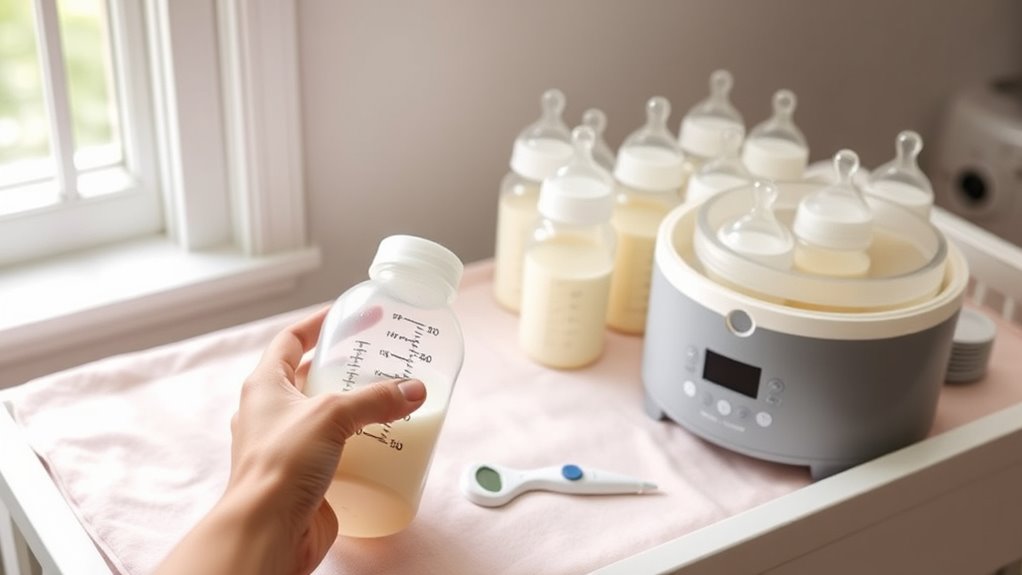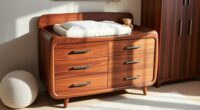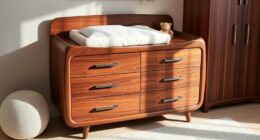To safely formula feed your baby, gather all supplies like bottles, nipples, and sterilizers, and always wash your hands beforehand. Follow instructions carefully for mixing the right amount of formula at the correct temperature, and use pre-measured powders for consistency. Store unused formula properly in a cool, dry place or refrigerate it for no more than 24 hours. If you’d like to discover more practical tips, you’ll find useful guidance to make feeding easier and safer.
Key Takeaways
- Sterilize bottles, nipples, and utensils before preparing formula to prevent bacteria.
- Follow the formula packaging instructions and use appropriate water temperature for mixing.
- Prepare amounts based on your baby’s hunger cues, typically 2-3 ounces per feeding for newborns.
- Store prepared formula in the refrigerator for no more than 24 hours and discard leftovers after feeding.
- Keep formula in a cool, dry, airtight environment, and avoid exposure to sunlight or heat sources.
Getting Started With Formula Feeding
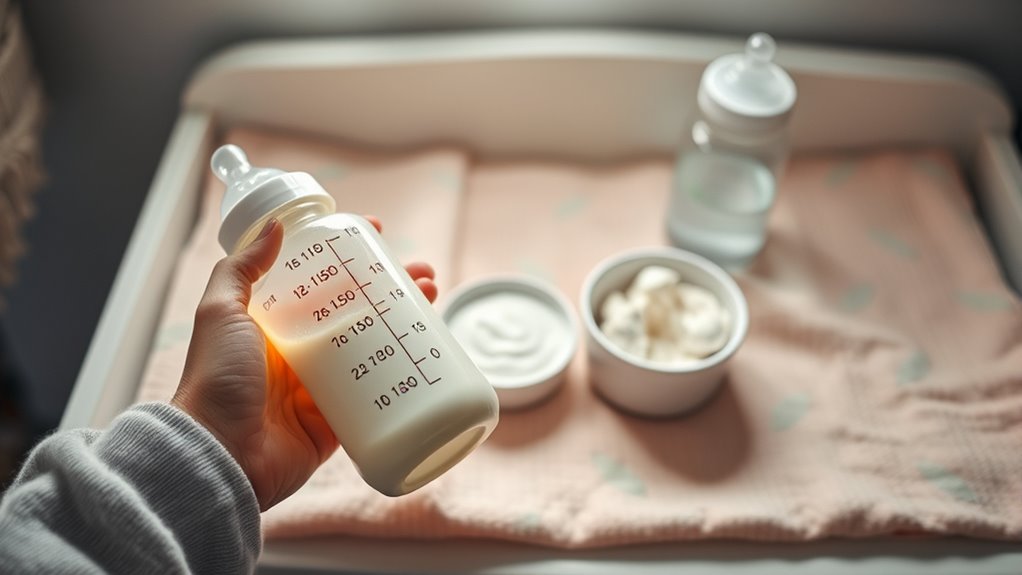
Starting formula feeding can feel overwhelming at first, but with the right approach, it becomes manageable. Begin by gathering essential feeding accessories like bottles, nipples, and a bottle brush for easy cleaning. Proper formula storage is vital—keep formula in a cool, dry place, and consider investing in airtight containers to keep it fresh. When preparing bottles, always follow the instructions on the formula packaging to ensure your baby receives the right nutrition. Pre-measured formula powders or liquid concentrates can make the process quicker and more consistent. Having everything organized and accessible will help you feel more confident during feedings. Remember, consistency and cleanliness are key to making formula feeding a smooth experience for both you and your baby. Incorporating modern technology such as bottle warmers or sterilizers can further streamline your routine and enhance safety. Additionally, understanding the importance of calibration ensures your preparations are accurate and safe for your infant. Being aware of support hours from resources like online support can also provide helpful guidance when needed.
How Much Formula Does Your Baby Need?
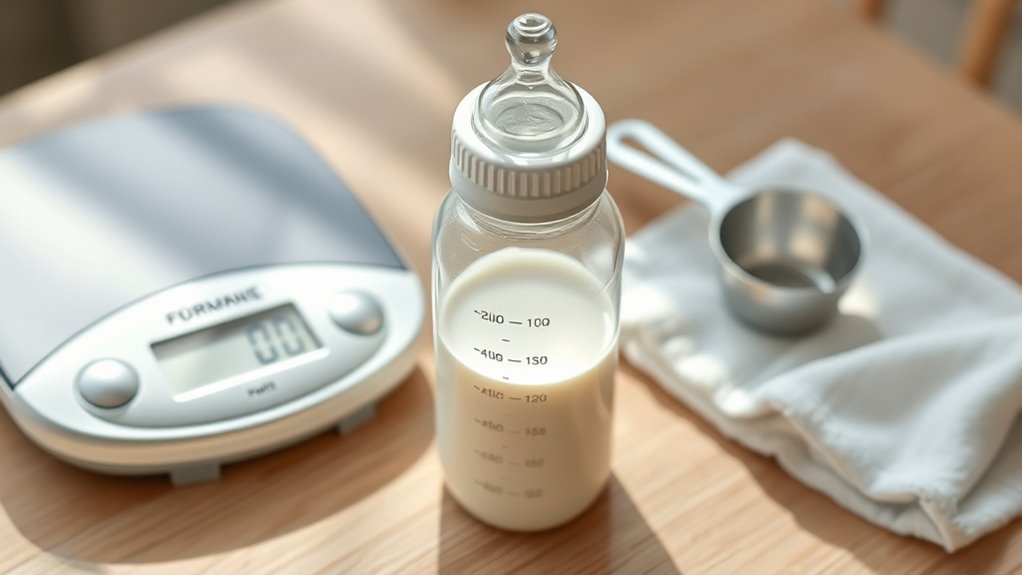
Understanding how much formula your baby needs can help you make sure they’re getting enough nutrition without overfeeding. Typically, newborns eat about 2-3 ounces per feeding, increasing as they grow. Keep in mind that feeding schedules vary, but most babies feed every 3-4 hours. To determine the right amount, consider these points:
- Use your baby’s hunger cues rather than sticking strictly to a schedule.
- Check the instructions on your chosen formula brand, as amounts can differ.
- Adjust quantities as your baby gains weight and shows signs of readiness for more or less.
- Incorporating natural materials and creating a cozy environment can also help your baby feel secure during feeding times.
Ensuring Safety During Formula Preparation

To guarantee your baby’s safety, it’s vital to prepare formula carefully and hygienically. Start by handling sterilization of bottles, nipples, and utensils to prevent bacteria growth. Always wash your hands thoroughly before preparing formula. Use clean, sterilized containers and follow proper storage tips: store prepared formula in the fridge for no more than 24 hours, and discard any leftover after feeding. When mixing, ensure water is at the correct temperature to kill germs and mix thoroughly. Keep formula away from direct sunlight and heat sources. Here’s a quick guide:
| Step | Action | Tip |
|---|---|---|
| Sterilization | Sterilize bottles and nipples | Use boiling water or sterilizer |
| Handling | Wash hands before preparation | Maintain hygiene at all times |
| Storage | Keep formula refrigerated | Use within 24 hours |
| Mixing | Use correct water temperature | Ensure safety and consistency |
Following these steps keeps your baby safe and healthy.
Frequently Asked Questions
Can I Mix Different Brands of Formula Safely?
You shouldn’t mix different brands of formula because it can affect brand compatibility and nutritional consistency. Each brand’s formula is specially designed with unique ingredients and nutrient levels, so combining them might lead to digestive issues or inadequate nutrition for your baby. Always choose one brand and stick with it, or consult your pediatrician if you’re considering switching or mixing formulas to make certain your baby’s safety and health.
How Long Can Prepared Formula Stay at Room Temperature?
You should discard prepared formula if it’s left at room temperature for more than 2 hours. For formula storage, always keep it in the refrigerator if not used immediately, and avoid leaving it out longer than recommended to guarantee room temperature safety. Bacteria can grow quickly at room temperature, so it’s best to prepare only what your baby needs and use it promptly to prevent spoilage and potential illness.
Is It Safe to Heat Formula in the Microwave?
Sure, heating formula in the microwave seems quick and easy, but heating safety experts warn against it. Microwave risks include uneven heating, creating hot spots that can burn your baby’s mouth, and destroying nutrients. Instead, you should warm formula safely by placing it in a bowl of warm water or using a bottle warmer. Avoid microwaves to guarantee your baby’s safety and maintain the formula’s nutritional integrity.
What Should I Do if My Baby Refuses the Formula?
If your baby refuses the formula, try offering it at different temperatures or in smaller amounts. You can explore alternative feeding methods like a different bottle or nipple type. Watch for signs of formula intolerance, such as fussiness, vomiting, or rashes. If refusal persists, consult your pediatrician to rule out allergies or other issues and discuss suitable alternatives to guarantee your baby gets proper nutrition.
Are There Specific Formulas for Babies With Allergies?
Yes, if your baby has allergies, you should look into hypoallergenic formulas, which are specially designed to diminish allergic reactions. You might also consider lactose-free options if your baby is sensitive to lactose. Always consult your pediatrician before switching formulas to guarantee you choose the best option for your baby’s specific needs. They can recommend the most suitable hypoallergenic or lactose-free formula to keep your baby safe and comfortable.
Conclusion
Remember, preparing formula is like planting a seed—you want to get it just right for healthy growth. When I first started, I worried I’d get the measurements wrong, but following the guidelines made it simple and safe. Just like tending a garden, consistency and attention keep your baby thriving. Trust yourself, stay vigilant, and soon formula feeding will feel natural, nurturing your little one just like sunlight helps a flower bloom.
